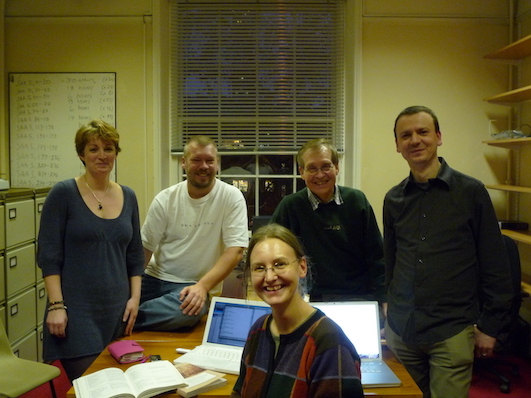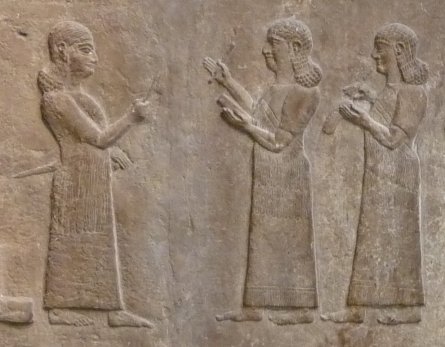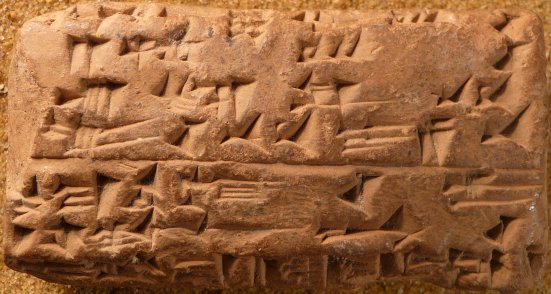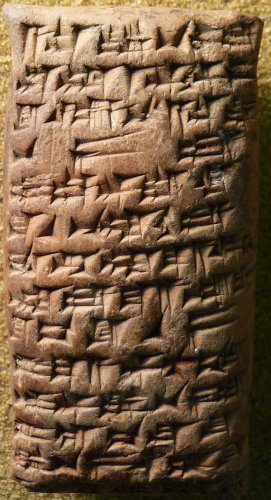About the project
The linguistically-tagged (lemmatised) transliterations and English translations presented on this open-access website are based on a heritage ASCII text dataset created by Simo Parpola and his team at the University of Helsinki (The Neo-Assyrian Text Corpus Project [http://www.helsinki.fi/science/saa/]), with the bulk of the data compiled in the 1980s and 1990s with principal funding by the Academy of Finland and the University of Helsinki.

From left to right: Eleanor Robson, Steve Tinney, Karen Radner, Simo Parpola, and Mikko Luukko in 2008 during a meeting in the UCL project room. In these early days of Oracc, the whiteboard in the back served to record the time spent on lemmatising groups of letters in order to track time-savings made through machine-learning as the body of lemmatised texts was growing.
After Parpola's retirement and with his encouragement, longtime NATCP member Karen Radner (then UCL, now LMU Munich) started in 2005 to explore ways of making the heritage data accessible to a wider audience as part of a collaboration with Eleanor Robson (then University of Cambridge, now UCL) and Steve Tinney (University of Philadelphia, Pennsylvania). This led to the creation of State Archives of Assyria online (SAAo), which since 2015 has been part of the data managed and maintained by the Munich Open-access Cuneiform Corpus Initiative [https://www.en.ag.geschichte.uni-muenchen.de/research/mocci/index.html] (MOCCI; directed by Karen Radner and Jamie Novotny).
State Archives of Assyria online (SAAo) currently comprises twenty-four sub-projects:
- twenty-one are adapted from the published volumes of the series State Archives of Assyria [http://assyriologia.fi/natcp/saa/],
- one is adapted from volume 2 (eponym lists and eponym chronicles) of the companion series State Archives of Assyria Studies [http://assyriologia.fi/natcp/saas/], and
- two — Knowledge and Power in the Neo-Assyrian Empire [/saao/knpp] and Assyrian Empire Builders [https://www.ucl.ac.uk/sargon/] — are digital resources that contextualise the rich Neo-Assyrian sources from Nineveh and Nimrud in their historical and cultural contexts.
The web presentation and linguistic annotation are carried out using tools and standards [http://oracc.museum.upenn.edu/] developed by Steve Tinney. As of March 2021, the 5058 Akkadian texts edited in SAA 1-21, as well as SAAS 2, have been fully lemmatised.

A pair of Assyrian scribes filing reports after the conquest of a Babylonian city (BM ANE 118882). The wall relief once decorated Tiglath-pileser III's Central Palace at Kalhu (modern Nimrud); photo by Karen Radner.
The creation of SAAo was made possible through the generous support of colleagues based at Cambridge, London, Munich, Philadelphia, and Vienna as part of research conducted with Austrian, German and UK funding. From 2007 until now, work on this long-term, open-access project has been carried out in three research phases:
- From January 2007 until January 2011, work was undertaken during the development of the website Knowledge and Power in the Neo-Assyrian Empire [/saao/knpp], which was funded by the UK Higher Education Academy;
- from October 2008 to March 2013, additional material was made available online as part of the research project "Mechanisms of communication in an ancient empire: the correspondence between the king of Assyria and his magnates in the 8th century BC [https://www.ucl.ac.uk/sargon/]," which was funded by the UK's Arts and Humanities Research Council; further lemmatising work was completed during this time in cooperation with the FWF-funded research project "Royal Institutional Households in First Millennium BC Mesopotamia" (S 10802-G18; University of Vienna), headed by Heather Baker (now University of Toronto); and
- since August 2015, SAAo has been part of the Munich Open-access Cuneiform Corpus Initiative [https://www.en.ag.geschichte.uni-muenchen.de/research/mocci/index.html] (MOCCI), which is based at and supported by Ludwig-Maximilians-Universität München [https://www.en.uni-muenchen.de/index.html]. Between 2015 and 2020, work on SAAo has been supported by LMU Munich and the Alexander von Humboldt Foundation [https://www.humboldt-foundation.de/web/home.html] through funds provided to LMU's Alexander von Humboldt Chair of the Ancient History of the Near and Middle East [https://www.en.ag.geschichte.uni-muenchen.de/chairs/chair_radner/staff_radner/index.html].

The obverse of an astrological report (SAA 8 287 [http://oracc.museum.upenn.edu/saao/saa08/P237866/]) from Nergal-eṭir to an Assyrian king mentioning a birth omen.
Knowledge and Power in the Neo-Assyrian Empire [/saao/knpp]
The website "Knowledge and Power in the Neo-Assyrian Empire" — created by Karen Radner, Eleanor Robson, and Steve Tinney — is dedicated to the 7th century letters, queries, and reports exchanged between kings Esarhaddon and Assurbanipal and their scholarly advisors. That project, which ran from 2007 to 2010, was not only the first Oracc-based project, but also the inaugural phase of SAAo. With the kind permission of the authors and the Neo-Assyrian Text Corpus Project [http://www.helsinki.fi/science/saa/] (NATCP), Tinney converted the editions of 2033 texts — the Neo-Assyrian letters, poetry, queries, and reports edited in eight volumes of the SAA series — from the NATC database to Oracc ASCII Transliteration Format (ATF). The Knowledge and Power corpus became the first Oracc dataset and it included fully searchable editions of the following SAA volumes:
- A. Livingstone, Assyrian court poetry and literary miscellanea (State Archives of Assyria 3 [/saao/saa03/]), Helsinki 1989
- I. Starr, Queries to the Sungod: divination and politics in Sargonid Assyria (State Archives of Assyria 4 [/saao/saa04/]), Helsinki 1990
- H. Hunger, Astrological reports to Assyrian kings (State Archives of Assyria 8 [/saao/saa08/]), Helsinki 1992
- S. Parpola, Assyrian prophecies (State Archives of Assyria 9 [/saao/saa09/]), Helsinki 1997
- S. Parpola, Letters from Assyrian and Babylonian scholars (State Archives of Assyria 10 [/saao/saa10/]), Helsinki 1993
- S. Cole and P. Machinist, Letters from priests to kings Esarhaddon and Assurbanipal (State Archives of Assyria 13 [/saao/saa13/]), Helsinki 1999
- M. Luukko and G. Van Buylaere, The political correspondence of Esarhaddon (State Archives of Assyria 16 [/saao/saa16/]), Helsinki 2002
- F. Reynolds, The Babylonian correspondence of Esarhaddon (State Archives of Assyria 18 [/saao/saa18/]), Helsinki 2003
Sponsors
Knowledge and Power was funded by an e-learning grant from the UK Higher Education Academy's Subject Centre for Philosophical and Religious Studies [https://www.heacademy.ac.uk] in 2007-8. Much of Eleanor Robson's time on the project in 2007 was supported by an Early Career Fellowship from the Centre for Research in Arts, Social Sciences, and Humanities [http://www.crassh.cam.ac.uk] at the University of Cambridge. Work on the Cuneiform Revealed section of the site was funded by a grant from the UK Higher Education Academy's Subject Centre for History, Classics and Archaeology [http://www.heacademy.ac.uk/hca] in 2009. John Curtis and Jonathan Taylor of the Middle East Department [http://www.britishmuseum.org/the_museum/departments/middle_east.aspx] of the British Museum [http://www.britishmuseum.org/] generously facilitated development of the Tablet gallery [/saao/knpp/cuneiformrevealed/tabletgallery/index.html], thereby making it possible for Cuneiform Revealed to contain numerous hi-resolution images of cuneiform tablets. The 2010 update was supported by a grant from University College London's Executive Sub-Committee on Innovations in Teaching Learning and Assessment (ESCILTA). Since August 2015, support for the maintenance of the website has been provided by LMU Munich [http://www.uni-muenchen.de/index.html] and the Alexander von Humboldt Foundation [https://www.humboldt-foundation.de/web/home.html] through the establishment of the Alexander von Humboldt Chair for Ancient History of the Near and Middle East [http://www.ag.geschichte.uni-muenchen.de/lehrstuehle/ls_radner/index.html]; see below for further details.
For further information, please visit the Knowledge and Power About the Project [/saao/knpp/abouttheproject/] page.


The obverse of a letter (SAA 5 241 [http://oracc.museum.upenn.edu/saao/saa05/P334357/]) from Adad-ibni to the king (Sargon II) mentioning that an unnamed Babylonian was sent to the palace.
Assyrian Empire Builders [https://www.ucl.ac.uk/sargon/]
The website "Assyrian empire builders: Governors, diplomats and soldiers in the service of Sargon II and Tiglath-pileser III, kings of Assyria" — created by Karen Radner — provides a context for the correspondence between the 8th-century-BC kings Tiglath-pileser III (744-727 BC) and Sargon II (721-705 BC) and their governors and magnates and presents these letters together with resources and materials for their study and on their historical and cultural context. The website was created as part of the AHRC-funded research project "Mechanisms of communication in an ancient empire: the correspondence between the king of Assyria and his magnates in the 8th century BC," which ran from October 2008 to March 2013 at UCL. The creation of this website, which went online in October 2009, constitutes the second and most productive phase of SAAo. With the kind permission of the authors and the Neo-Assyrian Text Corpus Project (NATCP), the editions of the remaining then-published SAA volumes, as well as those of one volume (eponym lists and eponym chronicles) of the companion series State Archives of Assyria Studies [http://assyriologia.fi/natcp/saas/] were converted from the NATC database to Oracc ASCII Transliteration Format (ATF). In total, 2807 texts were made accessible from the following twelve SAA and SAAS volumes:
- S. Parpola, The Correspondence of Sargon II, Part I: Letters from Assyria and the West (State Archives of Assyria 1 [/saao/saa01/]), Helsinki 1987
- S. Parpola and K. Watanabe, Neo-Assyrian Treaties and Loyalty Oaths (State Archives of Assyria 2 [/saao/saa02/]), Helsinki 1988
- G. B. Lanfranchi and S. Parpola, The Correspondence of Sargon II, Part II: Letters from the Northern and Northeastern Provinces (State Archives of Assyria 5 [/saao/saa05/]), Helsinki 1990
- T. Kwasman and S. Parpola, Legal Transactions of the Royal Court of Nineveh, Part I: Tiglath-Pileser III through Esarhaddon (State Archives of Assyria 6 [/saao/saa06/]), Helsinki, 1991
- F. M. Fales and J. N. Postgate, Imperial Administrative Records, Part I: Palace and Temple Administration (State Archives of Assyria 7 [/saao/saa07/]), Helsinki, 1992
- F. M. Fales and J. N. Postgate, Imperial Administrative Records, Part II: Provincial and Military Administration (State Archives of Assyria 11 [/saao/saa11/]), Helsinki, 1995
- L. Kataja and R. Whiting, Grants, Decrees and Gifts of the Neo-Assyrian Period (State Archives of Assyria 12 [/saao/saa12/]), Helsinki, 1995
- R. Mattila, Legal Transactions of the Royal Court of Nineveh, Part II: Assurbanipal Through Sin-šarru-iškun (State Archives of Assyria 14 [/saao/saa14/]), Helsinki, 2002
- A. Fuchs and S. Parpola, The Correspondence of Sargon II, Part III: Letters from Babylonia and the Eastern Provinces (State Archives of Assyria 15 [/saao/saa15/]), Helsinki 2001
- M. Dietrich, The Neo-Babylonian Correspondence of Sargon and Sennacherib (State Archives of Assyria 17 [/saao/saa17/]), Helsinki 2003
- M. Luukko, The Correspondence of Tiglath-pileser III and Sargon II from Calah/Nimrud (State Archives of Assyria 19 [/saao/saa19/]), Helsinki 2012
- A. R. Millard, The Eponyms of the Assyrian Empire 910-612 B.C. (State Archives of Assyria Studies 2 [/saao/saas2/]), Helsinki 1994
During the creation of the Assyrian Empire Builders portal, Mikko Luukko began lemmatising [http://oracc.museum.upenn.edu/doc/help/lemmatising/index.html] (linguistically tagging) the state correspondence of king Sargon II (published in volumes 1, 5, 15 and 17), as well as that of his father Tiglath-pileser III from Nimrud (published in SAA 19). During his time at UCL, Luukko also lemmatised three further volumes: SAA 9 (S. Parpola, Assyrian prophecies, Helsinki 1997), SAA 13 (S. Cole and P. Machinist, Letters from priests to kings Esarhaddon and Assurbanipal, Helsinki 1999), and SAA 16 (M. Luukko and G. Van Buylaere, The political correspondence of Esarhaddon, Helsinki 2002). In addition, in cooperation with Heather D. Baker (then at the University of Vienna) and as part of the research project "Royal Institutional Households in First Millennium BC Mesopotamia" (see below for funding details), Melanie Groß lemmatised the legal documents edited in SAA 6 (T. Kwasman and S. Parpola, Legal Transactions of the Royal Court of Nineveh, Part I: Tiglath-Pileser III through Esarhaddon, Helsinki, 1991) and SAA 14 (R. Mattila, Legal Transactions of the Royal Court of Nineveh, Part II: Assurbanipal Through Sin-šarru-iškun, Helsinki, 2002) under Luukko's guidance.
Of these 2807 Neo-Assyrian texts, only the 1389 letters edited in SAA 1, 5, 15, 17, and 19 formed the Assyrian Empire Builders' Oracc corpus. In 2014, after the conclusion of the research project "Mechanisms of communication in an ancient empire: the correspondence between the king of Assyria and his magnates in the 8th century BC," Radner, with the technical assistance of Steve Tinney, therefore officially launched the Oracc-hosted State Archives of Assyria online (SAAo) project. This website not only included the 2033 texts of the Knowledge and Power corpus (SAA 3-4, 8-10, 16, and 18) and the 1389 letters of the Assyrian Empire Builders corpus (SAA 1, 5, 15, 17, and 19), but also the 1418 Neo-Assyrian texts edited in the other then-published SAA series (SAA 2, 6-7, 11-12, and 14, as well as SAAS 2). Upon launch of the open-access SAAo website, 2685 texts of the 4840 fully searchable texts had been lemmatised.
Sponsors
The Assyrian Empire Builders website was part of the research project "Mechanisms of communication in an ancient empire: the correspondence between the king of Assyria and his magnates in the 8th century BC," funded by the UK's Arts and Humanities Research Council [http://www.ahrc.ac.uk] and housed at the History Department of University College London [http://www.ucl.ac.uk/history]. Funding for Melanie Groß's work on SAAo (the lemmatisation of SAA 6 and SAA 14) was part of the research project "Royal Institutional Households in First Millennium BC Mesopotamia" (Fonds zur Förderung der wissenschaftlichen Forschung, S 10802-G18; 2009-2011) headed by Heather D. Baker (then at the University of Vienna).
For further information, please visit the Assyrian Empire Builders About the Project [https://www.ucl.ac.uk/sargon/abouttheproject/] page.

Munich Open-access Cuneiform Corpus Initiative [https://www.en.ag.geschichte.uni-muenchen.de/research/mocci/index.html] (MOCCI)

In August 2015, as a key objective of the newly-established Chair for the Ancient History of the Near and Middle East [https://www.en.ag.geschichte.uni-muenchen.de/chairs/chair_radner/index.html] at the Historisches Seminar (Abteilung Alte Geschichte) of Ludwig-Maximilians-Universität München, Karen Radner and Jamie Novotny established the Munich Open-access Cuneiform Corpus Initiative (MOCCI) to widely disseminate, facilitate, and promote the active use and understanding of official inscriptions and archival texts of the Middle East in Antiquity in academia and beyond. SAAo became one of the flagship projects of MOCCI and the lemmatisation of the texts continued, together with extensive work on the texts' metadata and the addition of the contents of newly published SAA volumes.
From August 2015 to December 2020, the following work took place on SAAo:
- Jamie Novotny converted S. Parpola, Royal Rituals and Cultic Texts (State Archives of Assyria 20 [/saao/saa20/]), Winona Lake, IN, 2017; and S. Parpola, The Correspondence of Assurbanipal, Part I: Letters from Assyria, Babylonia, and Vassal States (State Archives of Assyria 21 [/saao/saa21/]), Winona Lake, IN, 2018;
- Nathan Morello updated and lemmatised A. R. Millard, The Eponyms of the Assyrian Empire 910-612 B.C. (State Archives of Assyria Studies 2 [/saao/saas2/]), Helsinki 1994;
- Mikko Lukko lemmatised the following SAA volumes:
- S. Parpola and K. Watanabe, Neo-Assyrian Treaties and Loyalty Oaths (State Archives of Assyria 2 [/saao/saa02/]), Helsinki 1988
- A. Livingstone, Assyrian court poetry and literary miscellanea (State Archives of Assyria 3 [/saao/saa03/]), Helsinki 1989.
- I. Starr, Queries to the Sungod: divination and politics in Sargonid Assyria (State Archives of Assyria 4 [/saao/saa04/]), Helsinki 1990
- F. M. Fales and J. N. Postgate, Imperial Administrative Records, Part I: Palace and Temple Administration (State Archives of Assyria 7 [/saao/saa07/]), Helsinki, 1992
- H. Hunger, Astrological reports to Assyrian kings (State Archives of Assyria 8 [/saao/saa08/]), Helsinki 1992
- S. Parpola, Letters from Assyrian and Babylonian scholars (State Archives of Assyria 10 [/saao/saa10/]), Helsinki 1993
- F. M. Fales and J. N. Postgate, Imperial Administrative Records, Part II: Provincial and Military Administration (State Archives of Assyria 11 [/saao/saa11/]), Helsinki, 1995
- L. Kataja and R. Whiting, Grants, Decrees and Gifts of the Neo-Assyrian Period (State Archives of Assyria 12 [/saao/saa12/]), Helsinki, 1995
- F. Reynolds, The Babylonian correspondence of Esarhaddon (State Archives of Assyria 18 [/saao/saa18/]), Helsinki 2003
- S. Parpola, Royal Rituals and Cultic Texts (State Archives of Assyria 20 [/saao/saa20/]), Winona Lake, IN, 2017
- S. Parpola, The Correspondence of Assurbanipal, Part I: Letters from Assyria, Babylonia, and Vassal States (State Archives of Assyria 21 [/saao/saa21/]), Winona Lake, IN, 2018.
As of 2020, all of the texts edited on SAAo have been lemmatized.
As part of MOCCI, SAAo is being incorporated into the fledgling, in-progress sub-project Archival Texts of the Middle East in Antiquity (ATMEA), a corpus-building project that will expand the Nineveh-focused SAAo corpus by adding annotated editions of archival texts discovered at the principal Assyrian cities Assur and Kalhu (Calah), as well as at smaller provincial sites such as Burmarina, Dur-Katlimmu, Ma'allanate, Til-Barsip, and Tušhan. Work on ATMEA is being carried out by Poppy Tushingham, with the assistance of Nathan Morello and Jamie Novotny.
Starting in May 2020, the MOCCI team has begun creating web versions of the SAA book introductions, as well as expanding and improving the corpus' metadata. At present, the introductions to SAA volumes 1-15, 17-21, as well as that of SAAS 2, have been converted to a searchable, open-access format. The introduction to SAA 16 will be converted to a user-friendly HTML format over the course of 2022, as team members continue to expand and improve SAAo.
Sponsors
Since its inception in August 2015, the Munich Open-access Cuneiform Corpus Initiative [https://www.en.ag.geschichte.uni-muenchen.de/research/mocci/index.html] (MOCCI) has been based at and supported by Ludwig-Maximilians-Universität München [https://www.en.uni-muenchen.de/index.html]. Between 2015 and 2020, work on MOCCI has been supported by LMU Munich and the Alexander von Humboldt Foundation [https://www.humboldt-foundation.de/web/home.html] through funds provided to LMU's Alexander von Humboldt Chair of the Ancient History of the Near and Middle East [https://www.en.ag.geschichte.uni-muenchen.de/chairs/chair_radner/staff_radner/index.html].
